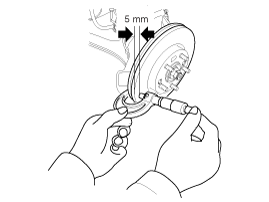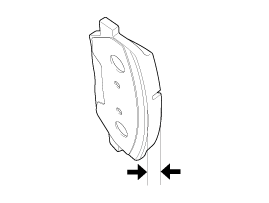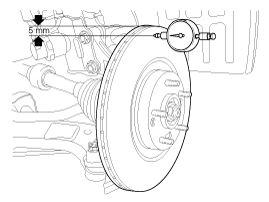 Kia Sorento: Front Disc Brake Inspection
Kia Sorento: Front Disc Brake Inspection
Second Generation XM (2011-2025) / Kia Sorento XM 2011-2025 Service Manual / Brake System / Brake System / Front Disc Brake Inspection
Front brake disc thickness check
| 1. |
Check the brake pads for wear and fade.
|
| 2. |
Check the brake disc for damage and cracks.
|
| 3. |
Remove all rust and contamination from the surface, and measure
the disc thickness at 8 points, at least, of same distance (5mm) from
the brake disc outer circle.
|
| 4. |
If wear exceeds the limit, replace the discs and pad assembly
left and right of the vehicle.
|
Front Brake Pad Check
| 1. |
Check the pad wear. Measure the pad thickness and replace it,
if it is less than the specified value.
|
| 2. |
Check that grease is applied, to sliding contact points and the
pad and backing metal for damage.
|
Front brake disc runout check
| 1. |
Place a dial gauge about 5mm (0.2 in.) from the outer circumference
of the brake disc, and measure the runout of the disc.
|
| 2. |
If the runout of the brake disc exceeds the limit specification,
replace the disc, and then measure the runout again.
|
| 3. |
If the runout does not exceed the limit specification, install
the brake disc after turning it 180┬░ and then check the runout of the
brake disc again.
|
| 4. |
If the runout cannot be corrected by changing the position of
the brake disc, replace the brake disc.
|
 Front Disc Brake Replacement
Front Disc Brake Replacement
Front brake pads
1.
Loosen the guide rod bolt (B) and then remove caliper body (A).
2.
Replace pad shim (D), pad retainers (C) and b ...
 Front Disc Brake Installation
Front Disc Brake Installation
1.
Installation is the reverse of removal.
2.
Compress the piston into the caliper body using the SST (09581-11000).
...
See also:
Windshield Glass Removal
ŌĆó
Put on gloves to protect your hands.
ŌĆó
...
Rear Upper Arm Inspection
1.
Check the bushing for wear and deterioration.
2.
Check the rear upper arm or damage and deformation.
3.
...
Component Location
1. Smart key unit
2. Door handle & door antenna
3. Interior antenna 2
4. Interior antenna 3
5. Tailgate switch
6. Bumper antenna
7. FOB key
8. IPM (Intelligent ...
Copyright ® www.ksmanual.com 2014-2025



